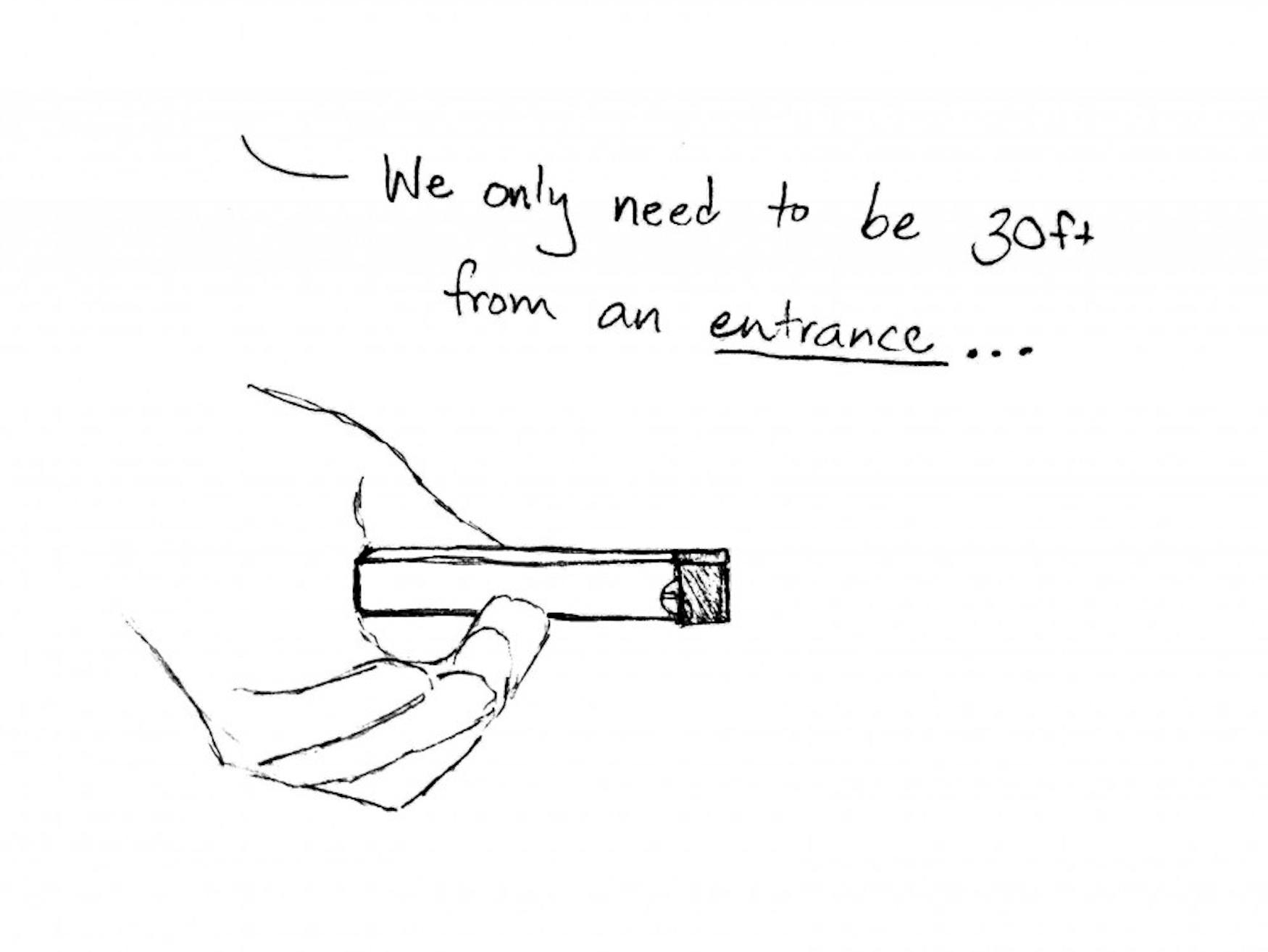Campus smoking policy poses a health risk for students
Spring is here, which means Brandesians are taking to the outdoors to … continue studying. Ever-industrious laptop and textbook-toters are settling in the two library-adjacent outdoor study spaces, as well as Mandel’s patios en masse. However, cigarette smoke dissuades many students from working outside. The two areas where tables are provided for students to gather outside are also popular spots for smokers, given Brandeis’ 30-foot rule regulating smoking on campus. As discussed in a 2014 Justice editorial, the rule prohibits smoking within 30 feet of a campus building entrance, but does little else. This rule is unfavorable to students and the University because it is difficult to enforce, poses a health hazard and disperses smoking-related garbage widely across campus. The Brandeis chapter of Colleges Against Cancer has advocated for changing this rule, but their complaints have fallen on deaf ears. As suggested in 2014, Brandeis should adopt smoke-free policies for outdoor campus areas and establish designated smoking areas. This would promote the use of outdoor spaces, improving both student health and the student experience, as well as the school’s image.
The Centers for Disease Control and Prevention estimates that since 1964, 2.5 million people have died from secondhand smoke. However, the CDC also recognizes that since the late 1980s, measurable health effects from secondhand smoke exposure have decreased considerably. This has been a product of movements by many public and private spaces toward increased regulation on smoking. The latest of these movements is by universities that are banning tobacco smoking on campus. Temple University pledged to join the growing list of smoke-free campuses on April 2. Previously, Temple had a 25-foot policy similar to that which is currently in place at Brandeis. The Philadelphia university president cited health concerns and the students’ negative experiences as reasons for the change in his campus-wide e-mail.
Brandeis’ existing 30-foot policy naturally clusters smokers by the two entrances to the library. This creates a public health issue in several ways. First, it does not address the issue of pathways which lead to the entrances. Anyone entering or leaving the library must walk directly through the smoke. Second, the policy doesn’t take into account other pedestrian routes that pass by the library. The walking path past the library towards Rabb and Upper Campus has the most foot traffic of any walking route on campus; any student walking from Lower Campus or the SCC to the Social Sciences and Humanities quads takes this path. This allows passive, unintentional exposure to secondhand smoke. Finally, the school’s outdoor study areas become de facto ashtrays rather than pleasant places to socialize or work. Brandeis’ campus layout exacerbates the need for a designated smoking area, since the library is located at the busiest area on campus in terms of pedestrian traffic.
In addition to functionally clustering smoking zones on the most populated parts of campus, the 30-foot policy is difficult to enforce. Updated in 2018, the policy states that “Smokers should stay at least 30 feet away from buildings as measured from the outermost wall
surfaces, doors, windows,” continuing that “where ventilation intake grates are present... the 30 feet should be measured outwards from there.” 30 feet is not a convenient distance to measure, and despite placards stating the rule on nearly every building, smokers standing closer to doorways are rarely reprimanded. By establishing specific areas for smoking, the University could make smoking rules easier to enforce, as well as clearer to everyone.
An Admissions tour guide who asked to remain anonymous reported feeling self-conscious when pausing tours near the library and Usdan student center because cigarette butts frequently litter the ground in these places. Since these areas aren’t official smoking zones, there are few ashtrays so smokers discard butts at random. Near outdoor tables, they pepper the Goldfarb Astroturf. Like other toxic trash left out in the open, crushed cigarette butts create environmental and health hazards, and additionally can discourage potential applicants. By creating and maintaining designated smoking areas, Brandeis would facilitate the proper disposal of smoking-related garbage. Facilities staff would have one place to collect trash from instead of having to pick up scattered litter, and the threat to birds and other animals from ingesting the butts would be mitigated.
Ultimately, it would be up to the University to decide where new smoking areas should be established. By analyzing foot traffic on campus, Brandeis should aim to place designated smoking area(s) in places where they will be used, but where foot traffic is not extremely high. This would maximize use of the areas and observance to the policy, while minimizing secondhand smoke exposure. The University should welcome student, faculty and staff feedback on this decision process, since they use and know the campus best. Two potential sites are the area between the Usdan Student Center and Skyline Residence Hall, behind (west) of Golding Judaica Center and north of Mandel. Obviously, more research needs to be conducted, but these sites have relatively little foot traffic compared to the currently used smoking areas outside the library, while being within walking distance to the people who may use them.
Brandeis needs to take action and join the growing movement towards smoke free college campuses. Student health and experience are the main issues at stake here, and limiting smoking to designated areas also boosts campus image and cleanliness. According to a July 2018 CDC report, over 2,000 campuses in the United States that have taken this route or eliminated smoking completely have had positive results. Exposure to any level of secondhand smoke is not safe, so keeping this exposure to a minimum needs to be a priority. Let’s take back the outdoor tables.



Please note All comments are eligible for publication in The Justice.